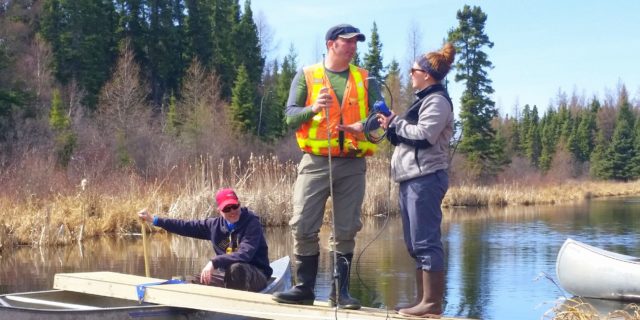
By
Brandice Hollier, Pete Whittington, and Christopher Malcolm
March 2017
Print Version
What you need to know
Wetlands are a vital part of many ecosystems, offering flood protection, water filtration, and habitat for many aquatic species. In some small northern communities, it is becoming more common to use wetlands as discharge points for treated wastewater effluent (i.e., from a sewage lagoon) to attenuate any nutrients before they make their way to a river or lake. This is because wetland vegetation is effective at taking up excess nutrients. The town of Wasagaming, in Riding Mountain National Park, is an example of this set-up, in which the town’s treated wastewater effluent is discharged from a sewage lagoon into Ominnik Marsh and then west to South Lake via a constructed channel, before flowing north into Clear Lake through a sand barrier bar; however, this was not the original flow path. In the original hydrologic flow path, Octopus Creek skirted Ominnik Marsh and flowed directly north into Clear Lake. The channel to South Lake was constructed in the early 1960s and has served to reduce the nutrient inputs to Clear Lake from the treated waste water effluent, as well as from Octopus Creek which receives runoff from neighbouring agricultural fields outside of the park boundary.
Why this research is important
Parks Canada’s mandate directs the park to manage for ecological integrity, which includes restoration of anthropogenically altered systems back to their natural conditions. In this case, restoration means re-aligning the original flow path of Octopus Creek. The question is: should they? The original diversion was created with the intention of minimizing nutrient loading to Clear Lake; thus there exists a quagmire between restoring the original flow path and potentially harming Clear Lake through nutrient loading, or not restoring, which not only could be argued disregards Parks Canada’s mandate, but may have an impact on critical northern pike spawning habitat in South Lake that requires high primary productivity. In addition, the importance of the nutrients now flowing into South Lake that helps the plants necessary for this spawning habitat is not known. Fortunately, through established hydrological and water chemistry techniques, we will be able to make an informed management recommendation to Parks Canada regarding Octopus Creek restoration, nutrient loading risk to Clear Lake the contribution of nutrients to South Lake through the current canal.
How the research is being done
A water balance approach is being used where we attempt to quantify the inflows and outflows of water from Ominnik Marsh and South Lake so that we know the relative importance of each flow to the overall water balance. Stream gauging, along with water samples (nitrogen and phosphorus), will determine the quantity and quality of surface water flowing into and out of Ominnik Marsh and South Lake. Data loggers installed at each of the study sites will monitor the water level throughout the study period providing a continuous record. Piezometers installed in the ground at different depths will determine groundwater fluxes, and meteorological conditions (precipitation, evaporation) are measured at a nearby Environment Canada weather station. Understanding the water chemistry at different points within the system is important as this will quantify the mass flux of nutrients and determine if the hydraulic retention time of the historical Octopus Creek is long enough to filter the potential excess nutrients out of the water before it enters into Clear Lake.
What the researchers found
Preliminary results show that the amount of surface water reaching South Lake through the human-constructed channel is minimal; therefore, diverting the water to Clear Lake back through Octopus Creek would likely have minimal impacts on South Lake. Results also show that surface water nutrient levels within the system are low, and that there is likely no concern if the original Octopus Creek flow path were to be reconstructed. For this upcoming summer, groundwater fluxes and evaporation rates will be the main focus of the researcher as they are the missing pieces for the water balance portion of the study.
How this research can be used
This research will be used by Parks Canada at Riding Mountain National Park to inform science-based integrated management plans. It will be used in conjunction with other collaborative research between RMNP and BU that has addressed hydrology, ecology, and wildlife management.
About the Researchers
Keywords
- ecological integrity
- hydrology
- Riding Mountain
- waste water treatment
- water quality
- wetlands
Editor: Christiane Ramsey
Read more BU Research
Research at Brandon University follows comprehensive policies designed to safeguard ethics, to ensure academic integrity, to protect human and animal welfare and to prevent conflicts of interest.


